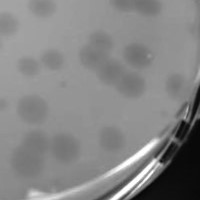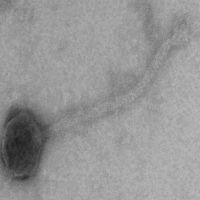Mycobacterium phage Muck
Know something about this phage that we don't? Modify its data.
| Detailed Information for Phage Muck | |
| Discovery Information | |
| Isolation Host | Mycobacterium smegmatis mc²155 |
| Found By | Eli Mucker |
| Year Found | 2023 |
| Location Found | Owensboro, KY United States of America |
| Finding Institution | Western Kentucky University |
| Program | Science Education Alliance-Phage Hunters Advancing Genomics and Evolutionary Science |
| From enriched soil sample? | Yes |
| Isolation Temperature | 30°C |
| GPS Coordinates | 37.743944 N, 87.056778 W Map |
| Discovery Notes | The bacteriophage was discovered in an arid, light brown soil environment heavily scattered with debris and leaf litter, adjacent to residential areas. The soil, noticeably desiccated and exhibiting a cracked, flaky texture, suggested a prolonged absence of moisture, possibly enduring several weeks without significant hydration. I collected my sample when it was 97-degrees Fahrenheit, the location was shaded. To collect the sample, only the top layer, approximately 2-3cm deep, was gathered. This selective sampling aimed to target the surface microbial community, thriving in the challenging and water-deprived conditions prevalent in this habitat. |
| Naming Notes | The name "Muck" for this bacteriophage perfectly encapsulates its roots in dirt and rubbish, echoing its origin. It's a fitting name not just because of the environment it was found in but also because it's a nod to my last name, Mucker. I felt a personal connection to this discovery, so naming it after me in a way feels like leaving a mark on the scientific journey. |
| Sequencing Information | |
| Sequencing Complete? | No |
| Genome length (bp) | Unknown |
| Character of genome ends | Unknown |
| Fasta file available? | No |
| Characterization | |
| Cluster | Unclustered |
| Subcluster | -- |
| Annotating Institution | Unknown or unassigned |
| Annotation Status | Not sequenced |
| Plaque Notes | The plaques formed by this phage display a turbid appearance with barely noticeable, organic circular more turbid halos. On average, these plaques measure around 4-5 millimeters in diameter. After a 48-hour incubation period at 30 degrees Celsius, these characteristics become evident allowing easy observation. |
| Morphotype | Siphoviridae |
| Has been Phamerated? | No |
| Publication Info | |
| Uploaded to GenBank? | No |
| GenBank Accession | None yet |
| Refseq Number | None yet |
| Archiving Info | |
| Archiving status | Not in Pitt Archives |
| SEA Lysate Titer | 10^-8 |
| Available Files | |
| Plaque Picture | Download |
| Restriction Digest Picture | Download |
| EM Picture | Download |

